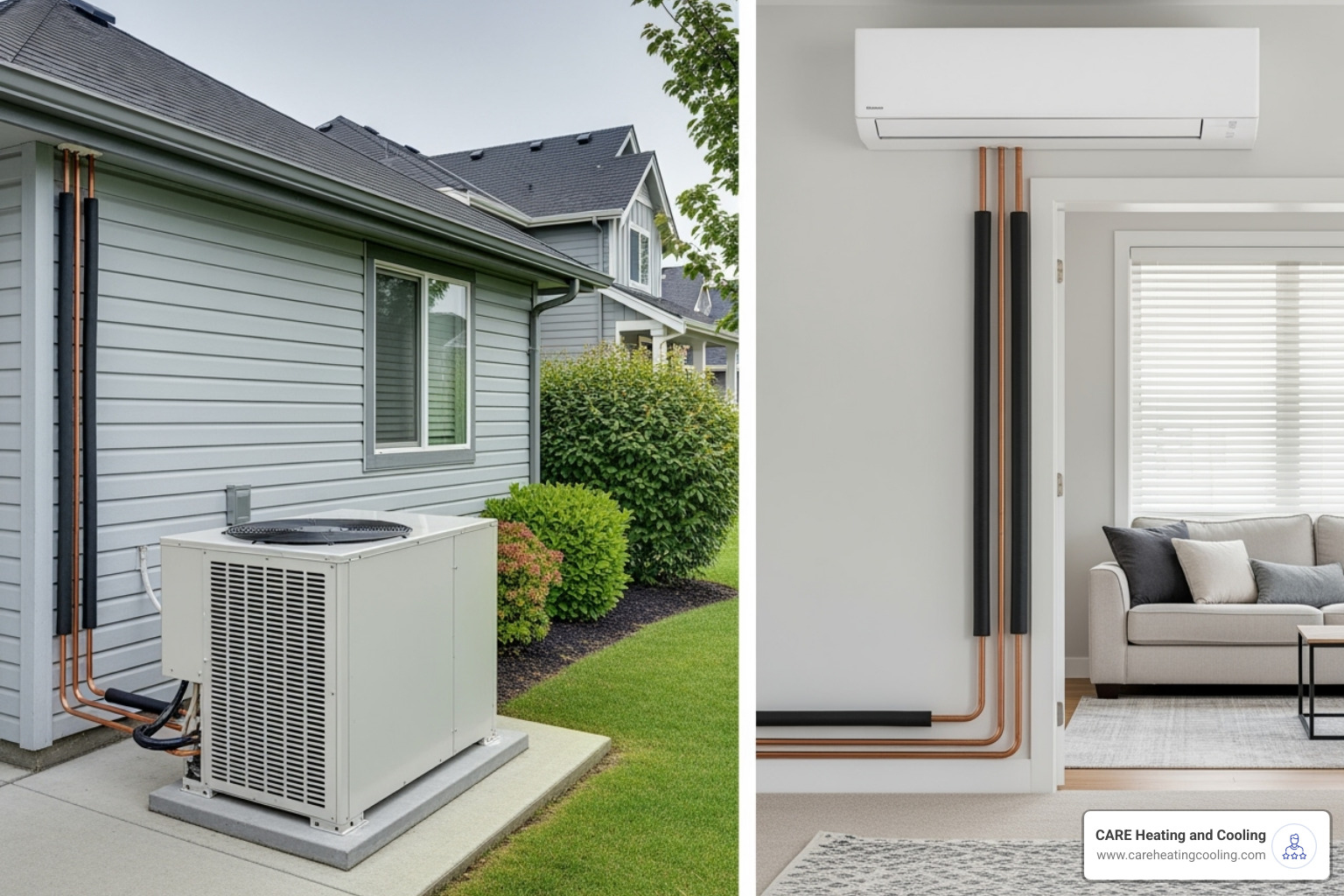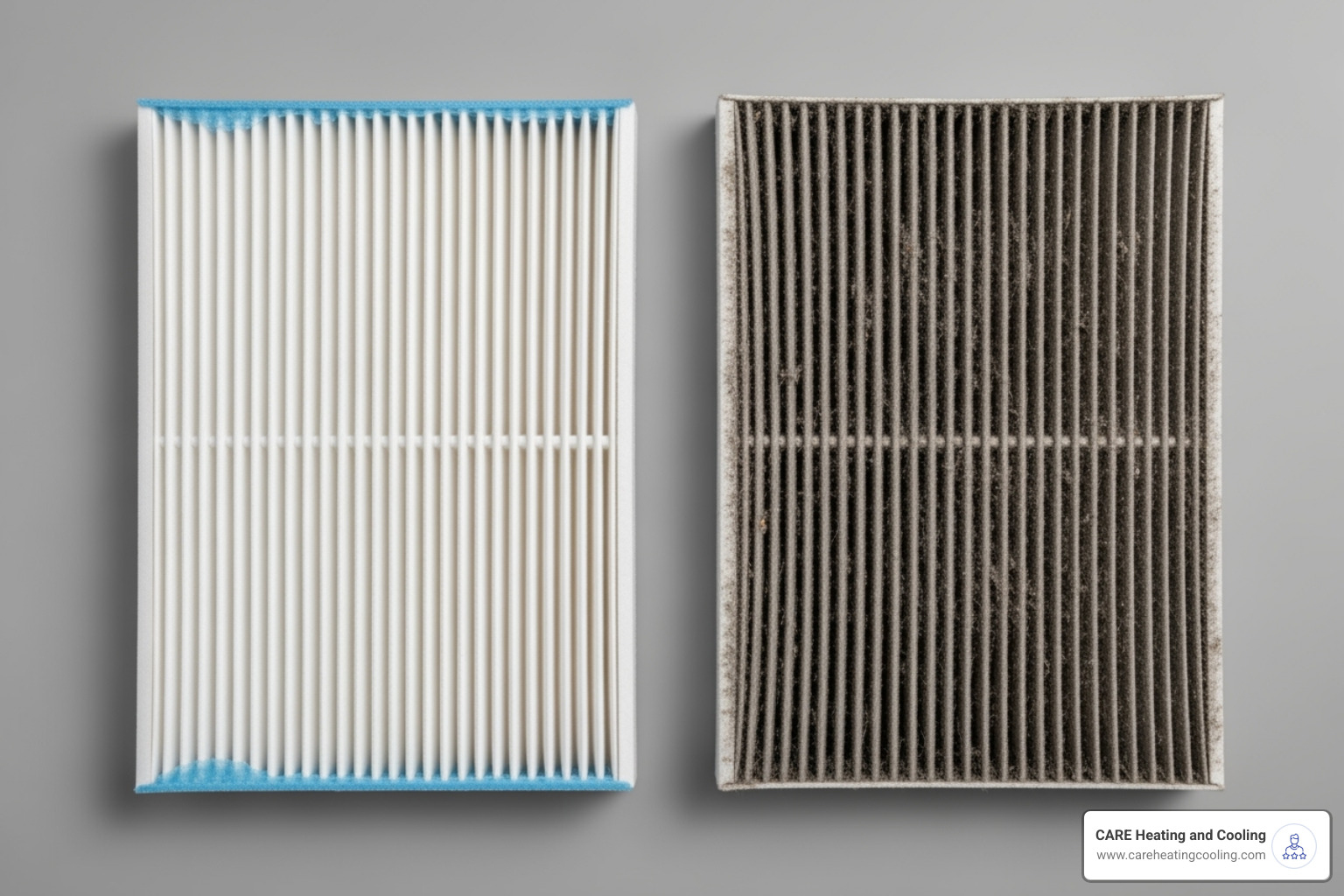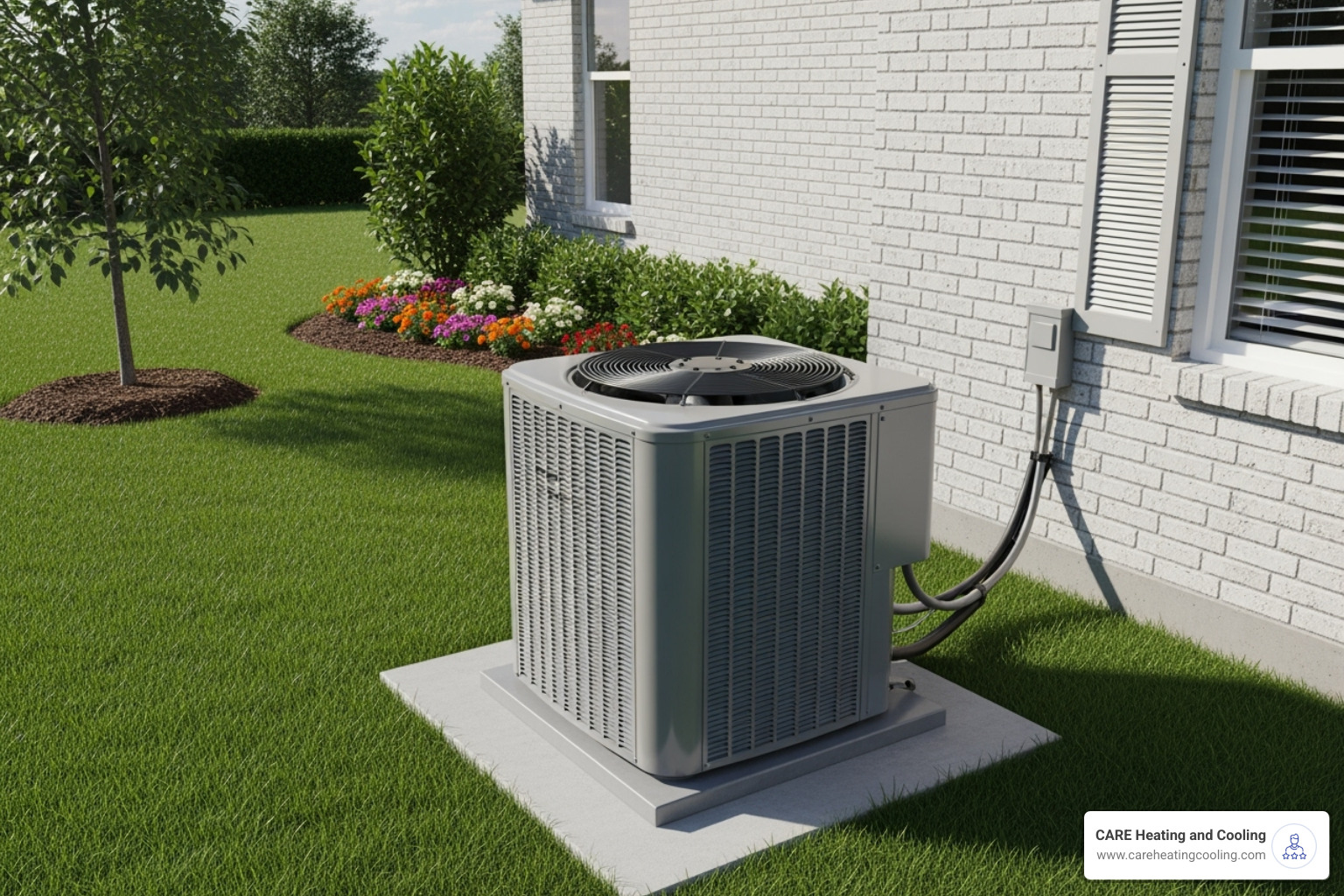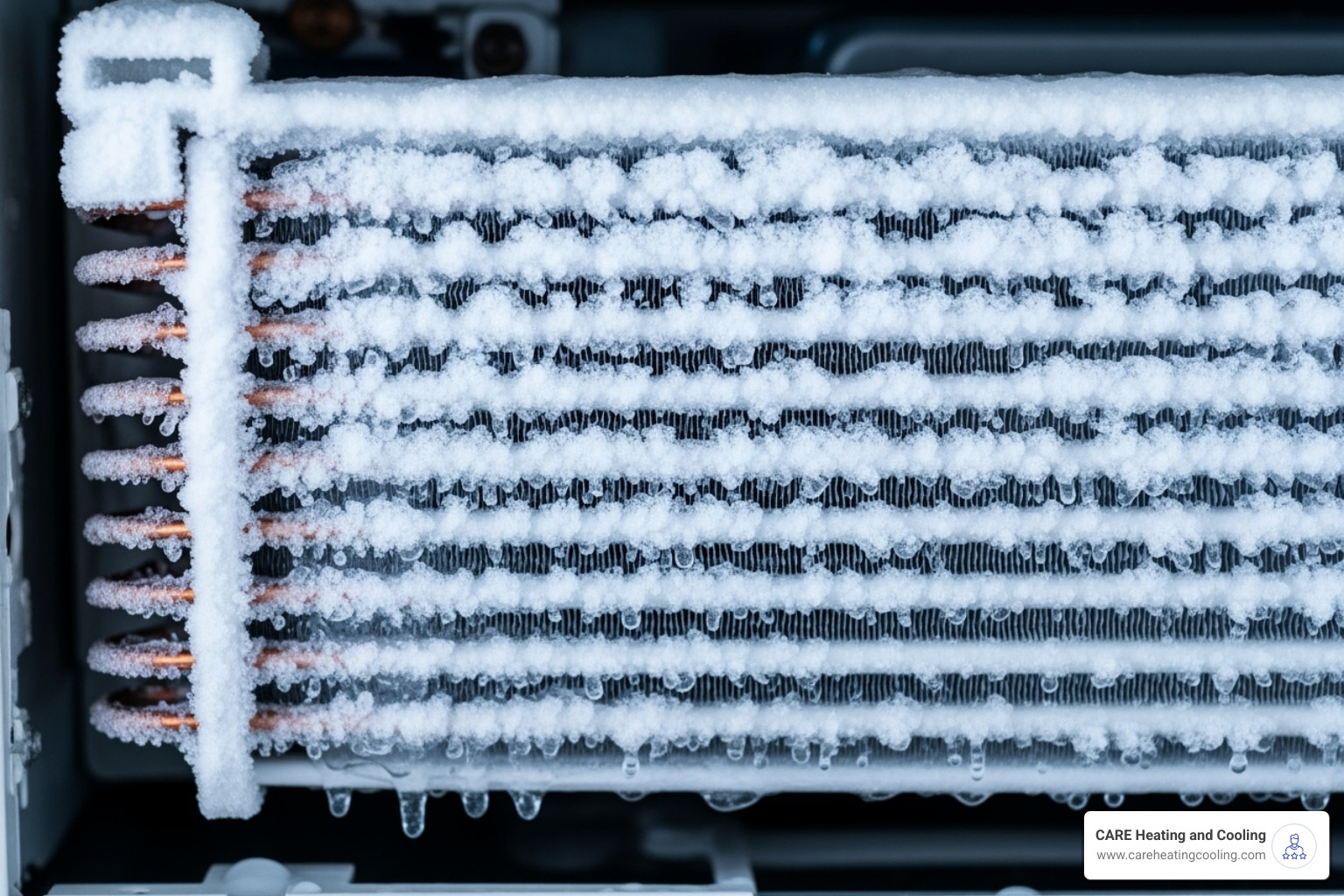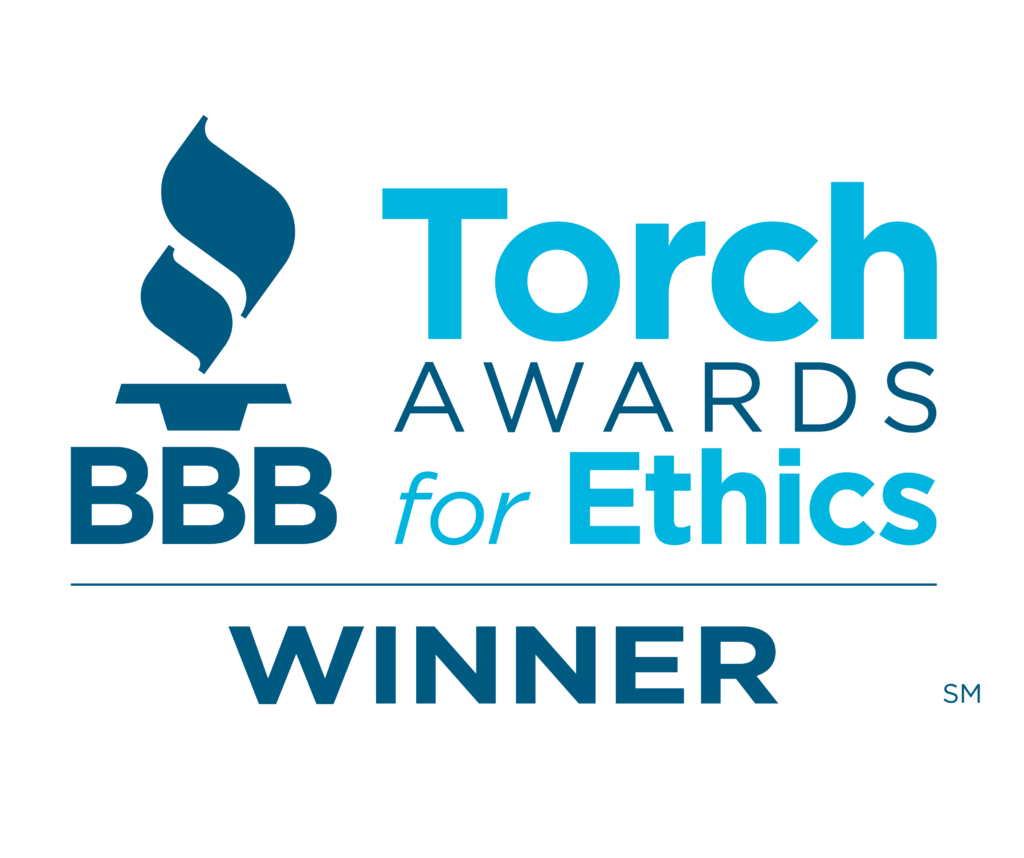When Your AC Betrays You: Understanding Warm Air Problems
AC blowing warm air is one of the most frustrating home comfort problems, especially during hot summer days. Here are the most common causes and what you can do about them:
Quick Diagnosis Guide:
- Check thermostat settings – Ensure it’s set to “Cool” and fan is on “Auto”
- Inspect air filter – Replace if dirty or clogged
- Look at outdoor unit – Clear debris and check for power
- Listen for unusual sounds – Hissing or clicking may indicate serious issues
- Call a professional if – Problem persists after basic checks
When you walk into your home expecting cool relief and are instead greeted by warm air from your AC vents, it’s a major disappointment. This problem affects thousands of homeowners every summer, but the good news is that many causes have simple solutions you can try yourself.
Some issues are quick fixes – like adjusting your thermostat or changing a dirty filter. Others require professional help – like refrigerant leaks or electrical problems that can be dangerous to handle alone.
The key is knowing which problems you can safely tackle and when to call for backup. Making the wrong choice could turn a simple repair into an expensive replacement.
First, Understand How Your AC Cools Your Home
Before troubleshooting why your AC is blowing warm air, it helps to understand how your air conditioner works. Your AC doesn’t actually “make” cool air; it’s a heat-moving system that takes warmth from inside your home and moves it outside.
The key to this process is refrigerant, a special chemical that travels through your system in a continuous loop, changing from liquid to gas and back again. This refrigerant cycle is what creates the cooling effect.
Your AC system has four main components working together:
The evaporator coil is inside your home’s air handler or furnace. When warm indoor air is pulled over these cold coils, the refrigerant inside absorbs the heat, turning from a liquid into a gas. Your blower fan then pushes the newly cooled air back through your vents.
The compressor, located in your outdoor unit, takes that warm refrigerant gas and squeezes it under high pressure, making it even hotter. This step is crucial for releasing the heat outside.
The condenser coil is also outside. As outdoor air flows over these coils, the heat the refrigerant collected from your home is released. As the refrigerant cools down, it turns back into a liquid.
Finally, the refrigerant passes through an expansion valve that drops its pressure and temperature, preparing it to start the whole heat transfer process over again.
When this cycle is working smoothly, your home stays cool. But when any part of this process is disrupted—due to issues with airflow, refrigerant, or mechanical parts—you end up with warm air instead of cool relief. Understanding the cooling process helps pinpoint where things might be going wrong.
Why Your AC is Blowing Warm Air: From Simple Fixes to Pro Repairs
When your AC starts blowing warm air, the good news is that many causes are surprisingly simple to fix yourself. Before you start, always turn off your AC at the thermostat and the circuit breaker. Your safety is worth more than a quick fix.
Some problems are DIY-friendly, like checking thermostat settings or changing a filter. Others involve refrigerant, electrical components, or mechanical parts that need professional hands. This guide will help you figure out which is which.
At CARE Heating and Cooling, we believe in empowering homeowners with knowledge. That’s why we’ve put together this guide covering Common AC Repair Issues & Expert Solutions that you might encounter.
Thermostat Troubles: The First Check for an AC Blowing Warm Air
Sometimes the problem isn’t your AC at all, but the thermostat. It’s always the first place you should check.
Start with the basics: make sure your thermostat is set to “Cool” and not accidentally switched to “Heat” or “Fan Only.” Then, check the temperature setting. If your home feels warm but the thermostat is set higher than the current room temperature, your AC is simply doing what it’s told. Set the temperature a few degrees below the room temperature to trigger the cooling cycle.
Another common issue is the fan setting. Check if your fan is on “ON” instead of “AUTO.” When set to “ON,” the fan runs constantly, even when the cooling cycle isn’t active, pushing unconditioned air through your vents.
Dead batteries in a digital thermostat can also cause problems. If your thermostat is unresponsive, try swapping in fresh batteries.
If your thermostat seems to be misreading temperatures or sending incorrect signals to your AC, it might need professional recalibration or replacement. Smart thermostats can help prevent these issues, as they are more precise and can alert you to system problems.
Clogged Air Filters and Blocked Vents
Dirty air filters are one of the most common culprits behind an AC blowing warm air. A clogged filter restricts airflow, forcing your system to work harder while delivering less cooling.
We recommend checking your filter monthly, especially during summer. Most systems need a new filter every one to three months, but homes with pets or in dusty areas may need more frequent changes.
Don’t forget about your vents. Return vents (the larger ones) pull air into your system. If they’re blocked by furniture or curtains, your AC can’t draw in enough air. Likewise, make sure nothing is blocking the supply vents where cool air comes out.
Go check your air filter now. If it’s dirty, replace it. Then, take a quick walk around your house to ensure all your vents can breathe freely. This five-minute check often solves the problem.
Outdoor Unit Obstructions and Power Issues
Your outdoor unit works hard to release the heat it pulled from your home. If it can’t do its job, you’ll get AC blowing warm air inside.
The condenser coils need to breathe. These metal fins release heat, but they can’t work effectively when clogged with dirt, leaves, or grass clippings. Clear away any debris, trim back plants, and ensure there’s at least two feet of space around the unit. You can gently clean the coils with a soft brush or garden hose, but turn off the power first and avoid high-pressure washing.
Sometimes the issue is a simple loss of power. AC systems use a lot of electricity, and a circuit breaker might trip to protect your home. Head to your electrical panel and look for any tripped breakers. If you find one, flip it completely off, then firmly back to on.
Important: If the breaker trips again immediately or repeatedly, don’t keep resetting it. This indicates a serious electrical problem that could be a fire hazard. While you can learn about using a multimeter safely, we strongly recommend calling professionals for any recurring electrical issues.
When to Call a Professional for Your AC
If you’ve checked your thermostat, replaced your air filter, and cleared debris from your outdoor unit, but your AC is still blowing warm air, it’s time to call a professional HVAC technician. Some AC problems require specialized tools, training, and safety equipment to handle properly. Attempting complex repairs yourself can turn a manageable fix into an expensive system replacement.
Knowing when to call for help protects you and your wallet. Our team at CARE Heating and Cooling has seen it all, and we’re here to help with these Signs You Need AC Repair.
Low Refrigerant and Leaks
When your system is low on refrigerant, your AC blowing warm air is inevitable. Your AC system is a closed loop, so refrigerant doesn’t get “used up.” If your system is low, it means you have a leak that needs professional attention.
Hissing or bubbling noises from your AC are often the first clue of a leak. You might also notice the system running constantly without cooling your home or a spike in your energy bills.
One of the most telling signs is frozen coils. When there isn’t enough refrigerant to absorb heat properly, the remaining refrigerant gets too cold, causing moisture to freeze on the evaporator coil.
Adding more refrigerant without fixing the leak won’t solve the problem and can cause more damage. This job requires specialized tools, EPA certification, and professional expertise to locate and repair the leak. Learn more about Signs of Refrigerant Leaks in Your AC.
Frozen Coils: A Telltale Sign Your AC is Blowing Warm Air
Ice forming on your AC while warm air comes from your vents is a clear sign of trouble. Frozen coils are a common reason for AC blowing warm air and definitely require a professional.
A frozen evaporator coil becomes an insulated block of ice and can’t absorb heat from your home’s air. The blower fan keeps running, but it’s just circulating unconditioned air.
Airflow problems (like dirty filters) or refrigerant issues are the usual culprits. If you find frozen coils, turn off your AC at the thermostat and switch the fan to “ON” to help melt the ice. This thawing process can take several hours.
If your coils keep freezing after you’ve addressed basic maintenance, it’s time for a professional diagnosis. Repeated freezing often indicates a refrigerant leak or other mechanical problem. For more insights, see Why Your AC Vents Are Blowing Warm Air.
Electrical and Mechanical Failures
Sometimes, the problem lies deep within the system’s electrical or mechanical parts. These issues are firmly in “professional repair territory,” and DIY fixes can be dangerous.
A faulty capacitor is a common issue. These components provide the electrical jolt to start your AC’s motors. When one fails, the motors won’t start, and your AC won’t cool.
The compressor is the heart of your cooling system. A malfunctioning compressor stops refrigerant circulation and all heat transfer. You might hear humming or loud, strange noises.
Your outdoor unit’s condenser fan motor pulls air over the coils to release heat. A broken motor will cause the unit to overheat and shut down.
Persistent clicking noises from the outdoor unit often indicate failing electrical components. While some clicking at startup is normal, constant clicking is a warning sign. Our Westerville neighbors can learn more about AC Makes Clicking Noises in Westerville.
Duct leaks can also be the source. When cool air escapes through cracks in your ductwork, it never reaches your living areas. According to Energy Star, leaking ducts can result in losing 20 to 30 percent of air, forcing your AC to work harder for less comfort.
While you can learn about using a multimeter safely, we strongly recommend leaving electrical troubleshooting to certified HVAC technicians for your safety.
Frequently Asked Questions about Warm Air from Your AC
When your AC is blowing warm air, you likely have questions. Here are answers to the most common ones we hear from homeowners in Ohio.
How much does it cost to fix an AC blowing warm air?
The cost to fix an AC blowing warm air depends entirely on the cause. A dirty air filter might only cost $10-20 to replace yourself. Resetting a tripped breaker is free.
However, more complex issues require a professional and are more expensive. Refrigerant leak repairs can vary widely depending on the leak’s location and severity. Major component replacements, like a new condenser unit or compressor, are more significant investments.
Most HVAC companies charge a diagnostic fee to identify the problem. At CARE Heating and Cooling, we provide transparent explanations and options. Our technicians are paid to fix your unit, not sell you a new one, ensuring we recommend the most cost-effective solution. Regular maintenance is the best way to avoid surprise repair bills.
Should I turn my AC off if it’s blowing warm air?
Yes, absolutely. Turn off your AC as soon as you notice it’s blowing warm air. It might be tempting to let it run, but you could be causing more damage.
Running a struggling AC can turn a simple repair into an expensive one. The compressor, the most expensive part of your system, can be permanently damaged if forced to run under stressful conditions. Your system will also waste energy trying to cool, increasing your utility bills for no reason.
Turn it off immediately if you notice:
- Strange grinding, banging, or loud hissing sounds
- Any burning smells
- Visible smoke or sparks
- Ice forming on your indoor unit
These signs indicate a serious problem where your safety is the priority.
What’s the difference between a home AC and a car AC blowing warm air?
While both systems use the same principle of moving heat, they are very different.
Your home AC is a permanent installation with separate indoor and outdoor units connected by refrigerant lines. The components are larger and designed to cool an entire house.
Car AC systems are compact and integrated into the vehicle. The components are designed to handle constant vibration and movement while cooling a much smaller space.
The refrigerants are also different. Most home systems use R-410A, while cars typically use R-134a.
In terms of problems, both can have refrigerant leaks or compressor issues. However, your home AC has unique challenges like dirty air filters, clogged outdoor coils from landscaping, and ductwork problems. Cars face issues from road debris and constant vibration.
While the basic principle is the same, fixing a home AC requires different expertise and tools than a car AC. That’s why you need a residential HVAC technician for your home system.
Preventative Maintenance for a Cool and Reliable Summer
The best way to prevent your AC blowing warm air is with preventative maintenance. A little regular care prevents big problems down the road. Most AC units can last 15 to 20 years when properly maintained, but neglect can lead to early and expensive replacements.
Regular filter replacement is the simplest and most effective task you can perform. Check your filter monthly during peak cooling season and replace it every one to three months. This will support consistent cooling and lower energy bills.
Cleaning your coils helps your AC breathe and release heat effectively. Your outdoor condenser coils can get buried under grass clippings, leaves, and dirt. A gentle rinse with a garden hose (with the power off!) can make a big difference. The indoor evaporator coils are best left to professionals during an annual tune-up.
Clearing drain lines prevents water leaks and backups. Your AC removes humidity from the air, and that water needs to drain away. A clogged drain line can cause significant water damage. A simple flush can keep it clear.
Annual tune-ups are crucial. A trained technician will give your system a thorough inspection, checking electrical connections, refrigerant levels, cleaning coils, lubricating parts, and ensuring proper calibration. Think of it as a physical for your AC, catching small issues before they become major problems.
These maintenance tasks don’t just prevent your AC blowing warm air—they also extend your AC’s lifespan and improve energy efficiency. A well-maintained system runs better, saves you money, and provides peace of mind. At CARE Heating and Cooling, our AC Service for Longevity and Efficiency focuses on keeping your system in peak condition.
Stay Cool with Trusted, Ethical Service
Dealing with an AC blowing warm air during peak summer heat is frustrating. While we’ve covered many DIY solutions, there comes a point when professional help isn’t just recommended—it’s necessary.
When should you definitely call a pro? If you’ve completed the basic checks—thermostat, filter, outdoor unit—and your AC is still blowing warm air, it’s time for an expert. Any issues involving electrical components, refrigerant leaks, or mechanical failures should always be left to trained professionals for your safety.
At CARE Heating and Cooling, we understand the frustration of a malfunctioning AC during an Ohio heatwave. We’ve built our reputation on being an HVAC company you can trust, earning us the BBB Torch Award for Ethics.
Here’s what makes us different: our technicians are paid to fix your unit, not to sell you a new one. When our team diagnoses your AC blowing warm air problem, you can trust that we’re focused on finding the most effective and honest solution for your situation.
Our approach is straightforward. We diagnose the issue, explain the problem in plain English, and give you honest recommendations. Whether it’s a simple repair or something more complex, we’ll walk you through your options.
We believe in customer-centric solutions because your comfort and satisfaction are our priority. This philosophy has helped us build lasting relationships with homeowners who count on us for reliable, ethical service.
Don’t suffer through the heat with an underperforming AC. Whether you need an expert diagnosis, a professional repair, or preventative maintenance, our team is ready to restore your home’s comfort.
Schedule your air conditioning repair in Westerville, OH today, and let’s get you back to enjoying the cool, refreshing air your home should provide!


